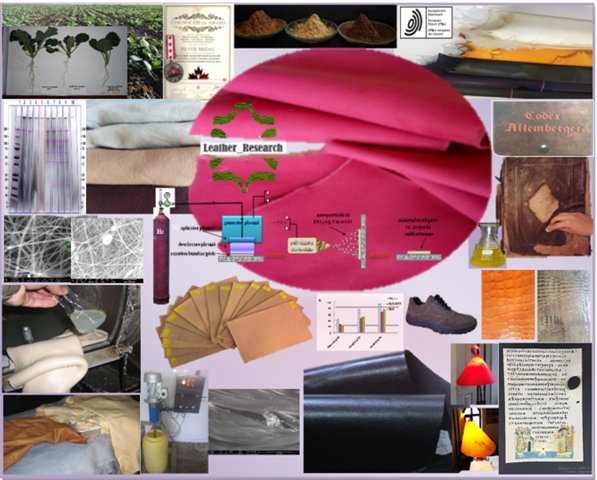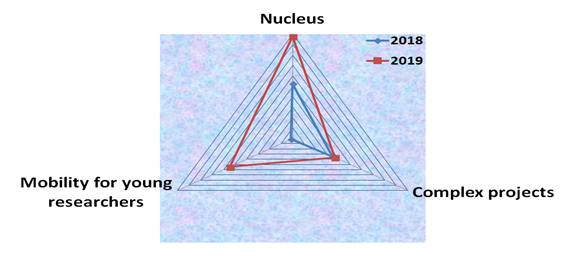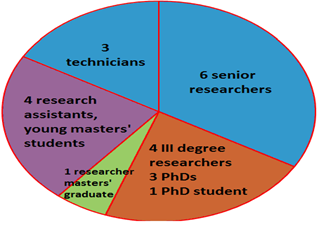Leather Research Department
Overview:
The Leather Research Department is anchored in maintaining the European tradition of the leather and footwear industry, recognized as a world leader in ecology and sustainability and having a key role in the global market.
The thematic areas of research addressed in 2019 are aligned with the European objectives regarding the role of interface between the leather industry, agriculture and society, by:
i) making smart materials to reduce environmental impact and increase competitiveness of the leather industry,
ii) superior use of protein by-products in a circular economy, with neutral environmental impact, and
iii) creating new methods of investigation and conservation of leather and parchment heritage objects, as a vector for the transmission of representative cultural messages over time.
Research results meet the demands of the industry, agriculture and cultural heritage regarding the development of ecological alternatives with neutral environmental impact, obtaining sustainable, smart materials that contribute to the protection of the environment, consumers and cultural values.
Regulations affecting the leather industry refer to pollution (REACH Regulation (1907/2006), Directive 96/61/EC on Integrated Pollution Prevention and Control), voluntary eco-labeling on carbon footprint and harmlessness of leather goods (OEKO-TEX®, LEATHER STANDARD) or certification of chemicals free of harmful compounds (øZHMC), which lead to increased competitiveness, involve continuous innovation of chemical materials, processes and high performance in the evaluation of potentially hazardous substances.
The areas of expertise of the Leather Research Department are structured within three research topics:
► Advanced materials, nanomaterials and smart technologies for the leather industry, with results in the application of new materials (organic and organo-metallic tanning agents from renewable resources, leather and fur free of chromium salts), nanomaterials (nanocomposites based on nano titanium dioxide, silicon dioxide, nano Ag, nano Cu, graphene oxide, with photocatalytic activity in the UV and visible domain and with antimicrobial and photocatalytic properties) and smart technologies (including unconventional technologies using gamma radiation, plasma, electrospraying) to obtain leather with biocidal, self-cleaning properties, with ecological impact on the environment and consumers.
► Biomaterials based on proteins and plant extracts for applications in industry, agriculture and other fields, with achievements on advanced technologies and additives for leather processing and for other applications: foliar fertilizers, growth stimulating agents, nutrition and treatment of plants and seeds, protein nanostructures with bioactive properties, vegetable tannins from alternative resources, protein and herbal auxiliaries for leather and fur processing.
► Study, characterization and diagnosis of heritage objects made of leather, parchment and wood, with results regarding the elaboration of the protocols to assess degradation stage, deterioration mechanisms, methods of prevention and conservation, development of software dedicated to environmental monitoring or the acquisition of data regarding behavior in hydrodynamic tests, approach of innovative cleaning and preservation techniques, development of new leather and parchment materials, and emulsifiers and preservation agents for heritage objects or for creative industries.
The department's expertise was leveraged through consulting services, technological transfer, technical assistance, dissemination and education activities for:
● evaluating new plant-based materials regarding tanning capacity, which underlies the design of new ecological materials;
● development of parchment for ecclesiastic use and for the creative industries;
● making leather for heritage bookbinding;
● development of products for maintenance of natural heritage leather;
● technological transfer for leather and footwear manufacturing;
● mentoring in European Project Semester (UPB).

Research facilities and infrastructure: Leather Research Department
Projects developed in 2019: 23 projects, presented below:
● Innovative technologies for making leather assortments with advanced properties, in accordance with circular economy principles (CREATIV_PIEL), NUCLEU, 16N/08.02.2019, PN 19 17 01 02, 8.02.2019-9.12.2019.
● Integrated system for analysis, diagnosis and conservation of modern and contemporary works of art (Mnemo ART), NUCLEU, 16N/08.02.2019, PN 19 17 05 01, 8.02.2019-9.12.2019.
● Innovative materials and technologies for sustainable leather manufacturing for automotive, InSuLA, European and International Cooperation - Subprogram 3.2 - Horizon 2020 ERANETCOFUND-MANUNET, 01.05.2018-30.04.2020.
● New hybrid nano-composites for smart leather processing with low environmental impact, HNAN, PN-III-P3-3.1-PM-RO-CN, 03.07.2018-31.12.2019.
● Advanced applications of non-thermal plasma in the field of cultural and artistic heritage; treatment of natural polymeric materials, SUSPLART, PN-III P3-3.5-EUK-2016-0030, 14.06.2017-14.06.2019.
● New treatment for rape seeds based on collagen hydrolysates, in order to increase the drought resistance of the rape seedling, COLL-RAPE, PN-III P3-3.5-EUK-2016, 09.08.2017-08.08.2020.
● Implementation and exploitation of scientific research results in the practice of restoration and conservation of cultural goods, IMPLEMENT, PN-III-P1-1.2-PCCDI-2017-0878, 01.03.2018-31.08.2020.
● Interinstitutional Program for the Development of Advanced Solutions Based on Eco-Nanotechnologies for Multifunctional Treatments of Textiles and Leather, PHYSforTeL, PN-III-P1-1.2-PCCDI-2017-0743, 01.03.2018-31.08.2020.
● Nuclear techniques for the conservation of heritage objects made of wood, NUTECO, Program 5, Subprogram 5.2(5/5.2/CEA-RO),01.08.2016-31.07.2019.
● Development of institutional performance and increasing excellence in RDI activity of INCDTP, 4PERFORM-TEX-PEL, PNCDI III-1- 1.2, 16.10.2018-29.11.2020.
● Post-doc project: “Synthesis and characterisation of keratin nanoparticles functionalized with vegetable extracts”, within the program “Work-based learning systems through entrepreneurial scholarships for postdoctoral fellows-SIMBA” (UPB), 10.07.2019-9.01.2021.
● Short Term Scientific Mission (STSM) ECOST-STSM-Request-CA15114-44124, “Antimicrobial nanofiber-based membranes from biopolymers obtained from leather industry by-products”, conducted at the Faculty of Technology Novi Sad, University of Novi Sad, Serbia and funded by AMiCI COST Action-44124, 14-26.04.2019.
● 11 projects for awarding research results: PN-III-P1-1.1-PRECBVT-2019-2233, PN-III-P1-1.1-PRECISI-2019-37387, PN-III-P1-1.1-PRECISI-2019-55500, PN-III-P1-1.1- PRECISI-2019-55584, PN-III-P1-1.1-PRECISI-2019-33522, PN-III-P1-1.1-PRECISI-2019-37387, PN-III-P1-1.1-PRECBVT-2019-1944, PN-III-P1-1.1-PRECBVT-2019-55563, PN-III-P1-1.1-PRECISI-2019-32760, PN-III-P1-1.1- PRECBVT2019-2212, PN-III-P1-1.1- PRECBVT-2019- 1983.

Fig. 1. Graphic representation of the dynamics of institutional development and mobility projects for young researchers
Figure 1 shows that in 2019 the values of projects dedicated to institutional development (Nucleu, Complex Projects) and to training of young specialists (scholarships for mobility) were on the rise, as a result of participating in the project dedicated to institutional excellence. Also, there is a substantial increase in projects for awarding research results (233% more than in 2018), as a result of the completion of a large number of national and international projects. Although the number of projects increased in 2019, their value decreased by 22.5% due to the lack of national competitions, especially technology transfer projects, and to the lower value for international projects, which are in the final implementation stage.
The scientific activity carried out in 2019: The results of scientific activity carried out in 2019 materialized in: 20 articles published in ISI indexed journals with a cumulated impact factor of 54.148 (IF=2.7/article) 4 articles in international database indexed journals, 3 books, 142 citations in Web of Science, 34 scientific communications presented in international conferences, 10 patents and patent applications (9 national and 1 EPO) and 4 awards. The year 2019 was marked by an intense activity of training young researchers, including by participating in international training scholarships in renown research groups: Institut de Recherches sur la Catalyse et l'Environnement de Lyon, Paris, University of Zagreb, Institute for Biological Systems (ISB), CNR Research Area of Rome, Istituto Nazionale di Fisica Nucleare (INFN) - Laboratori Nazionali del Sud (LNS), Catania, University of Turin - Department of Chemistry, University of Pisa.

Fig. 2 Human resource structure of the Leather Research Department
Research team: The research team of the Leather Research Department (Figure 2) is made up of 18 persons, of which 15 are certified in research, and 9 are doctors in the field of chemical engineering. The human resource structure is made up of 6 certified I degree researchers, 4 certified III degree researchers, 1 certified researcher, 4 certified scientific research assistants and 3 technicians. The relational framework at national and international level is demonstrated by the number of strategic partnerships concluded with: ► Universities and public institutions in Romania: University of Bucharest, “Politehnica” University of Bucharest, University of Agronomic Sciences and Veterinary Medicine of Bucharest, “Dimitrie Gusti” National Village Museum, National University of Arts of Bucharest, “Dunărea de Jos” University of Galati; ► Research institutes in Romania: “Horia Hulubei” National Research and Development Institute for Nuclear Physics and Engineering, National Research and Development Institute for Isotopic and Molecular Technologies of Cluj-Napoca, National Research and Development Institute for Chemistry and Petrochemistry - ICECHIM Bucharest; National Institute for Research and Development for Optoelectronics - INOE 2000, The National Institute of Materials Physics, “Petru Poni” Institute for Macromolecular Chemistry; National Heritage Institute, University of Art and Design of Cluj; ► Industrial partners from Romania: SC Pielorex SA, SC Probstdorfer Saatzucht Romania SRL, Oscar Print SRL, Manufactura Com Ana SRL; ► Universities and research centers from abroad: University of Turin, Italy; Łukasiewicz Research Network-Leather Industry Institute Lodz Poland-, Xi’an University RP China, Science and Technology Department of Sichuan Province; ► Industrial partners from abroad: Smit & Zoon, Netherlands; Metec Network srl, Italy; Kemia Tau, Italy. Perspectives and targeted research directions: The areas that will be addressed take into account the objectives of the Horizon Europe program on circular economy, technologies and materials to ensure environmental neutrality and competitiveness of the leather industry, materials and technologies for the creative industry, heritage conservation through digitization, unconventional techniques with favourable environmental impact and which contributes to the reduction of pollution and climate change, recovery of organic by-products and reintegration into the agricultural circuit, with a favourable impact on food and consumers, etc. Contact person: Dr. Carmen Gaidau Head of Leather Research Department e-mail: carmen.gaidau@icpi.ro